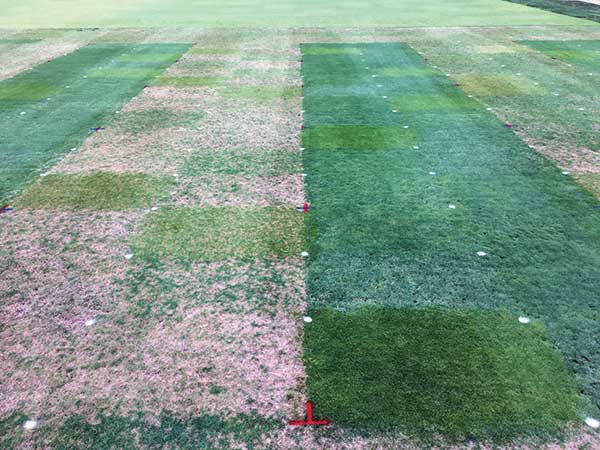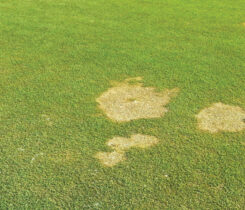Keeping dollar spot in check

The photo shows plots no longer receiving fungicide applications (left) and those that are treated (right). The five trial runs allowed the Rutgers University team to monitor disease progression through the entire season (April to November). (Photo: James Hempfling)
Our research team evaluated dollar spot (Clarireedia jacksonii) incidence and disease progress on six bentgrasses that vary in tolerance to the disease. Two weather-based models were used to predict dollar spot epidemics on those cultivars and species. We also investigated the effect of initial fungicide application timing on dollar spot incidence and disease progress on two bentgrass cultivars with low or high susceptibility to dollar spot. Then we determined the effect of the initial fungicide timing on the total fungicide usage for each cultivar. We based subsequent applications on either a disease threshold (at the first appearance of disease symptoms) or a predictive model (risk index = 20 percent).
Although we are continuing this project, there are interesting preliminary observations to report. Dollar spot forecasting with the logistic model had good accuracy during the middle of the growing season for the highly susceptible cultivars during 2015, 2016 and 2017.
However, our research showed that the risk index selected was too low for the resistant cultivars. We also observed that disease recovery during periods of a decreasing risk index might require a risk adjustment to improve disease prediction.
The threshold-based applications reduced total fungicide inputs and the level of disease control, which ranged from moderate to excellent, depending on the cultivar. Total fungicide input varied with the cultivar and, to a lesser extent, the initial fungicide timing factor.
Threshold-based fungicide applications on Declaration (low susceptibility) creeping bentgrass produced excellent disease control and required only one to five fungicide applications depending on the year and initial fungicide timing. In contrast, threshold-based fungicide applications on Independence (highly susceptible) creeping bentgrass produced moderate disease control and required four to nine applications depending on the year and initial fungicide timing.
James A. Murphy, Ph.D., and Bruce B. Clarke, Ph.D., are in the Department of Plant Biology and Pathology at Rutgers University. James Hempfling, Ph.D., is in Environmental Science Field Solutions at Bayer. You can reach James Murphy at jamurphy@njaes. rutgers.edu. This project was funded in part by the USGA Green Section.












